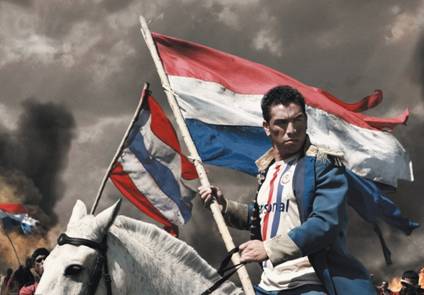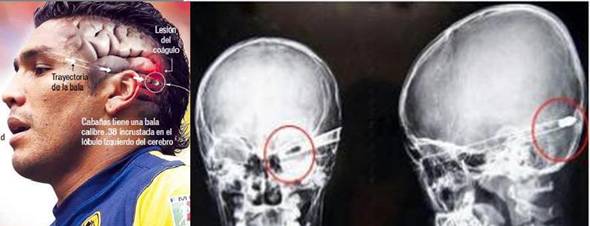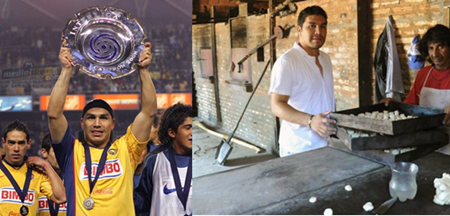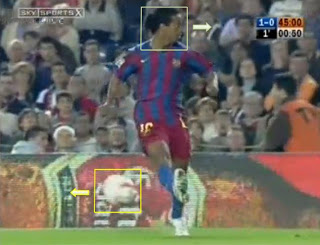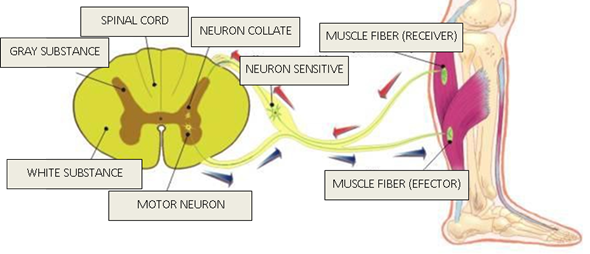The acquired brain damage of Marshal Salvador Cabañas
On the 16th day of the tournament ending in Mexico, Cabañas, a striker for the American team who was facing the defenders from the Monterrey club, suddenly stole the ball at midfield. Anticipating his rival midfielders mistakes when they reacted to the his move, Cabañas was already three meters in front of him. Once he closed in to score a goal, Salvador convinced them that he would move to his left, however, this was a hoax, as using all his mental power of prediction, he convinced the cognitive system of his opponents to incorrectly interpret his behavior, and at the least expected moment, he changed direction to go right and avoid both of them. Not satisfied with this, he deceived the defense again, including the goalkeeper, by convincing them that he would shoot but he did not shoot, and once again, now with the goalkeeper and two defenders on the ground, Cabañas kicked and scored an excellent goal(4).
In another magical scene, in a match in the preliminary round for the 2010 World Cup in South Africa, Salvador Cabañas received the ball three-fourths of the way down the field and convinced three players from the Argentina team that he had come to score a goal so that they fall into the classic trap of the Paraguayan who left these rivals by convincing them that he would move against the defenders, then passed the ball to a teammate in a classic wall, to once again receive the ball, and in just thousandths of seconds, react to leave the banquet served to his striker teammate to score a goal. The rest is history...Paraguay qualified for the World Cup, Cabañas was a national hero, and the President of the Republic declared a national holiday to celebrate the victory(5).
For these and other actions, Cabañas was named a Marshal of Paraguay, which completed his selection to the highest positions of the football world. He also participated in 2009 as the image in an advertising campaigns where he is represented as a true national leader (Figure 1). However, with the injustices that life presents to humans, all this leadership and magic would not have a happy ending.
In January 2010 the magic game of Cabañas received the hardest foul of his career. It was not a malicious defense that swept in from behind, damaging his ligaments, or a bad movement that injured some important part of his lower limbs. No, that did not happen; it was also not a kick that would break some part of his legs, stopping him from continuing to play; no, none of that. His legs did not receive any damage, and moreover, his legs were always intact. The victim was his brain.
According to the Americanista Club website(6), the morning of January 26, 2010 Marshal Cabañas was shot in the frontal area, not involving brain areas of neurovegetative control; therefore, he survived this incident. Moreover, as with the famous Phineas Gage(7), Cabañas arrived at the hospital conscious, saying to his wife "we are going to be fine"(8) as happens to patients who receives an open brain injury(9). However, hours later it would be known that the brain areas that control the regulation of cognitive functions of high complexity, which characterized him as a star player and an infallible striker, would be significantly affected.
The surgery which saved Cabañas life lasted about seven hours, a craniotomy was performed to remove a clot and stop bleeding in the frontal area. Neurosurgeons said that they would not extract the projectile because trying to do so would have generated greater damage from that already done by the shot(8). Figure 2 shows the trajectory of the projectile received by Cabañas.
Once he was stable and discharged from the first hospital where he was treated, he began the long hike that only his family and other families who have suffered brain damage will understand, to search for some therapeutic process of neuropsychological rehabilitation(26) which would be able to return the Grand Marshal to the field. However, as with other patients assisted in neuropsychological rehabilitation, the expression "I just want to be who I was before," is a desire that neuropsychological rehabilitation cannot yet bring about, just as it happened with Marshal Cabañas. He will recover, to some extent, his prior brain functioning, however, but depending on the age and intensity of the brain injury, like Cabañas, most patients will never be the same as they were before their injury(10)(11).
About six months after receiving cognitive treatments, a press conference was held to explain Cabañas’ mental state. From the panel of experts, a physician took the floor, and due to the sports journalists pressure that the only thing that they wanted to know was if Marshal Cabañas would return to play football as before, his strong response was heard: "absolutely no, a football reinsertion is dismissed"(12) because one of the functions of the frontal lobe (working memory) is affected. In this case, the following situation might happen: when he receives the ball, he would have to stop, stop looking at the ball and make a voluntary visual tracking, observing the player that is nearby, and then go back to look at the ball. Nevertheless, when he would return to look at the ball, he would have to start the whole process again, to know to whom he will make the pass, as experts say his brain damage "will enable him to remember that a defender ran down to his left", but "his short term memory, related to learning, is affected"(12) and therefore his practice of football, in the best of cases, would be closer to that of an amateur and never to the great professional level we used to see.
What's more, and such as(3) happened to Chris Prat or Elliot(13) after brain damage, Marshal Cabañas lost everything, not only the majesty to score goals, but all that in his day he won: his properties in Cancun and Acapulco, his partner, his expensive jewelry, his work, his money, in brief, everything he built, when his nervous system worked so magically(14).
Consider this: Salvador Cabañas’ legs were never affected after the shot, so we affirm as neuroscientists that his talent was not in his legs, as it is believed in the football context, his talent was in his brain mass that one day was damaged by the bullet that is now lodged in the left hemisphere. The great striker of the América football club is now the assistant in his father’s bakery in the humble village of Itauguá in Paraguay (Figure 3).
Which cerebral functions are activated in a magical football player such as Marshal Cabañas?
As you can recognize up to this point, brain function is a key part in the performance of a footballer, and therefore we will now try to demonstrate an approximation of the brain functions that would be activated in magical soccer players such as Marshal Cabañas.
Working memory
This is a classic, executive function of the dorsolateral frontal cortex which allows you to keep information in order while performing a certain task, as in the query when clinical neuropsychologists ask you to repeat a series of digits in reverse order(15). Then, as you can understand the activity of this function of high complexity in the footballer. For example, when Ronaldinho performed his classic touch to one place as he watched another, this function can be analyzed with a clinical eye, because when he was to receive the ball, he already knew in his mind the the sequence of information for the next move. However, he had to receive the ball and make the pretense that he was going to pass to another place by looking towards that place to which we should believe that he would pass, and following the information he had in his mind, he was executing a move that surprised the opposing players, as well as many of the thousands of spectators who came to see him (Figure 4).
The inhibitory control of automatic pulses
There are different levels in which a human being can react to a particular situation, for example, (a) in fully automatic way, where subcortical structures of the nervous system are participating, (b) semi-conscious, where basic neuropsychological functions are participating, and (c) a conscious response control, which includes the participation of areas of the brain from the cerebral portion of greater human ontogeny, the frontal cortex(16)(17).
Accordingly, when a footballer acts, for example, to make a pass or a attempt a goal, this is likely to result from the levels previously described, whereas focusing only on both ends (automatic and conscious / regulated), might be closer to what would be an explanation of the result that exists in the player who acts from both levels.
According to Carlson(18) when a stimulus generates a tendency of human response, if this is automatic, as for example in the reflection of withdrawal before a painful element requiring such action, there will be a reaction to which the neocortex does not participate, moreover, this will activate motor neurons that control the action (Figure 5).
Nevertheless, when there is a conscious control that stops the automatic neuronal response, this should activate additional parts of the brain that allow the motor neurons to generate an automatic response. Then, in the brain, specifically at the frontal level, inhibitory control stops the process of automatic action and will exchange it for a fully conscious and controlled reaction(25). Thus, when a human being is getting a tattoo or is in front of a needle, the second case will act automatically from the spinal cord, sending a motor neuronal response of automatic removal. However, to make the tattoo, the brain will intervene in the inhibitory control that will then allow the subject to exhibit controlled and regulated behavior, and therefore not remove the part of the body involved, even though it may be experiencing pain.
In this way, we can see with greater clarity that when a player makes a conscious and regulated move, interneurons that inhibit an automatic motor response (Figure 6) will be activated. This can be seen in a move such as in the case of Cabañas’ goal described previously, where any player who had failed to inhibit the automatic motor neuronal response had fired a shot in the first instance, decreasing the probabilities of getting the goal. However, Cabañas inhibited the automatic tendency and planned his move to delay execution of the shot until the defenders and goalkeeper were completely defeated.
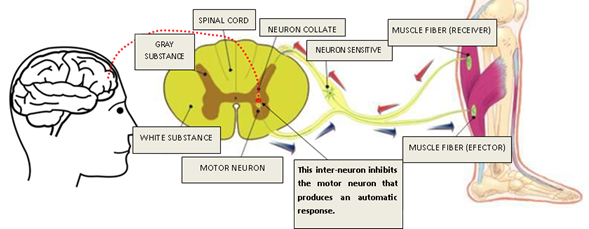
Figure 6 Structures of the nervous system involved in the inhibition of an automatic motor response.
To operate correctly, the inhibitory control in the player’s brain would need to be able to control its automatic motor neuronal responses that arise during each move that would thus normally give to the opposing player, based on the patterns of moves already stored in the brain, the ability to calculate a response that neutralizes the usual response from the opponent. However, if, as we saw in Cabañas or as we are delighted to see in Messi’s play on the field, this response is inhibited by inter-neuron automatic tendency and instead the player executes an action from the top cognitive supervisory system, the player will be well rid of the opposing player.
Another example in which the automatic inhibition of a motor neuron can be observed, occurs when the player controls the automatic tendency to shoot and completes the play by inhibiting the response and making a pass to another player who could be in the best position for scoring. Such is the case of what you usually see in the players to whom sports commentators often refer to as having “player’s brains” or as the ‘brain equipment’, as we recognize for the Spaniard Andrés Iniesta(19), who is a planner so that his fellow players shine with his great planning of moves.
It is interesting to underline that in football players must innovate in their repertoire of moves because if they are used in each match, it is possible to predict the action that the player will take on each occasion. Another trend of automatic behavior that should be inhibited by a player is the return to repeating a previous pattern, because you would have already become predictable and would fail against the rival. Instead, the player must activate another brain function of high complexity, cognitive flexibility.
Cognitive flexibility
Classic behavior observed in the patient who has suffered frontal brain damage is the perseveration(20), which is characterized by the presence of a repetitive behavior, and without the flexibility to answer questions, solve problems, deal with situations, or react to stimuli(21). In an opposite situation, in the undamaged brain of a football player who has developed a good functioning of cognitive flexibility, could develop different, creative strategies to solve a particular problem, so that the standard repertoire that allows successful moves is constantly updated and allows the player to deal flexibly to new situations(22) which may occur in unusual fields of play.
Thus, in order to beat an opponent, a football player has to use cognitive flexibility to solve the diverse situations that arise in the field of play. For example, it would be interesting to answer the related question of why a computer gamers can succeed in one context, but then fail when starting to play on a computer from another country of origin. This could be because the player is not sufficiently flexible at the cognitive level to change his schemes for solving behavioral problems, and instead uses his usual repertoire, which allowed him to succeed in the previous context, but that are not useful in solving the novel problems with which he is now faced. If there is a trend toward perseveration, it is likely that the player will fail in the new context. However, if the brain acts from the dorsolateral prefrontal cortex, it will be able to update the player’s behavioral repertoire and find creative solutions that will allow him to succeed in the new context which has developed.
So now this brain function of a talented football player can be understood as the execution of complex functional processes of the brain(27) which we have analyzed and visualized here. Nevertheless, this processing and brain structure go beyond having had the good fortune of possessing an adequately structured nervous system, since, although these talented players have a good biological basis, prolonged and tough work has enabled them to establish and improve the neural structures that allow them to shine on the field.
In this sense, the neuroscientist Richard Restak(23) is emphatic in stating that a true mastery of any discipline occurs through repetition, and it is repetition that generates a real neural network from practiced activity, so that it takes around 10 years to become an expert in your discipline. Such is the case of the prodigious players, who before reaching their grand debut, received a high training to acquire the skills necessary to perform successfully on the field, which is nothing more than the cluster of dendritic nerves that were generating the synaptic connections of majestic players such as Messi or Ronaldinho.
Decision making
It is interesting to see how the processing of the brain to make decisions may be more efficient in some players who, in thousandths of a second, can make a decision with a best future outcome. And here we mean players who make this type of decisions in their normal game and is not just any particular decisions that are due to random chance and that happen to make have good results.
Such is the case that we have identified in the play of Messi, who has a brain that can process information so efficiently that in a fraction of a second he can make decisions that will exclude other options and direct his moves towards happy results. This situation occurs because the human brain is a real machine that is constantly calculating probabilities and in the case of Messi, in fractions of a second, decides whether it is better to jump, run, shoot, or make a pass, and that in general, the move has a happy ending that we often see in the context of football. Thus, before the ball reaches Messi’s feet, he would already have a clear vision of the play that he will makes seconds later(13).
As Damasio mentions(13), the decision making machinery of a player like Messi is so efficient that each move is an unpredictable action that, since more than 20 years ago, express a game in which his opponents are not able to predict effectively the moves of the Argentine. For this reason, decision making, as well as the memory of repetitive practice that we have described, along with inhibitory control and cognitive flexibility, is another brain function that makes it possible for us to understand the differences in the resolution of problems that talented football players must demonstrate.
Discussion
So fragile and so magnificent: the human brain may be damaged in a second
In general, in the training of an athlete, greater importance is given to sports training and to the physical care that must be given to the parts of the body that are engaged in the activity of the athlete Thus, there is a desire for the athlete to not suffer injuries to what is seen as the most valuable parts for playing the sport. However, in many cases they forget about the most sensitive organ for the control of cognition and behavior, the brain, which will allow the true success of a human being.
Such was the case of the great striker Cabañas, who suffered a brain injury that caused him to lose his cognitive functions of high complexity that previously had allowed him to shine on the football field, but which, after the injury, led to a decline that resulted in him losing everything so that today, along with many other people who have survived brain damage, he faces an uncertain future. Nowadays Cabañas has managed to get up in some way. He runs a a sport center and trains a fourth division team, dreaming on going back to the place in which one day, the brain injury snatched(29).
Despite the fragility of the human brain and its supremacy in the success of a football player, there is not always a consciousness of care, since in many times, the highest care is given to the lower extremities, while the real magic, as we have tried to describe in the present article, is in the brain; legs come next. If not, examine the phenomenon of Ronaldo, to whom life broke his knees several times. However, with his undamaged brain, he returned stronger and stronger to the field of play (24).
It is essential to make it clear that we have only examined certain brain functions that would be involved in the success of a football player, and left many unanalyzed, for example, the role of attention and its connecting threads (attention has been mentioned in this article as being focused, sustained, selective, alternating, and divided) ( 28), the role of the regulation of the inner language of behavior and cognition, along with memory and other brain functions that allow human beings to have adaptive behavior day by day.
As future research that might emerge from this article, of central interest to us is an analysis of the impact of a program of stimulation of brain functions in football players to determine its impact on the performance of the different skills that a footballer should put into practice in each game.













